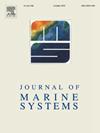Red Sea warming and its links to the Red Sea dipole and upwelling mechanisms
IF 2.5
3区 地球科学
Q2 GEOSCIENCES, MULTIDISCIPLINARY
引用次数: 0
Abstract
A comprehensive analysis of changes in sea surface temperature (SST) was performed across the Red Sea for the period 2003 to 2020 using satellite data from the Moderate Resolution Imaging Spectroradiometer (MODIS) Aqua. Employing a regionalization scheme based on principal component analysis (PCA), five homogenous sub-regions were identified that explain about 85 % of the total variation in SST across the Red Sea. The results indicate that there is a diverse and complex range of SST variability throughout the Red Sea. Spatially, distinct SST trends were observed between the southern (PC1) and northern (PC3) regions, which show northward enhancement in the rate of SST trends. A zonal contrast in the rate of warming over the western and eastern sectors was also observed, exhibiting more pronounced warming trends along the western coasts. In contrast to the offshore and deep waters, surface warming in shallow waters (depth < 100 m) was more pronounced, which poses detrimental effects (e.g., thermal coral bleaching) on regional marine ecosystems. We found a robust link between spatial patterns of SST anomalies and the phases of the Red Sea Dipole (RSD). This connection was largely regulated by the upwelling associated with the local wind-stress-curl. Further, the spatial and temporal patterns of wind-driven upwelling (i.e., coastal and wind-stress-curl-driven upwelling) were reminiscent of the SST trend, highlighting the significant role of the upwelling mechanism in the SST budget and trend across the Red Sea. The positive phase of the RSD aligns with periods of stronger Toker Jet activity, reinforcing cold SST anomalies in the southern Red Sea due to enhanced upwelling-induced cooling. However, the impacts of wind-driven upwelling on local SST differ from region to region, highlighting the need to employ a high-resolution wind dataset in the simulation of SST across the Red Sea. Overall, our findings offer insights into the complex mechanisms and factors influencing SST variability in the Red Sea, thereby contributing to improving coastal zone management and environmental planning efforts.

红海变暖及其与红海偶极子和上升流机制的联系
利用中分辨率成像光谱辐射计(MODIS) Aqua卫星数据,对2003 - 2020年红海海域的海表温度(SST)变化进行了综合分析。采用基于主成分分析(PCA)的分区方案,确定了5个同质子区域,它们解释了红海海温总变化的85%左右。结果表明,整个红海海温的变化范围多样而复杂。空间上,南(PC1)区和北(PC3)区海温趋势明显,海温趋势速率向北增强。还观察到东部和西部变暖速率的纬向差异,沿西海岸显示出更明显的变暖趋势。与近海和深水相比,浅水(depth <;100米)更为明显,这对区域海洋生态系统造成有害影响(例如,热珊瑚白化)。我们发现了海温异常的空间格局与红海偶极子(RSD)相之间的强大联系。这种联系在很大程度上是由与当地风应力旋度相关的上升流调节的。此外,风驱动上升流(即沿海和风应力-涡驱动的上升流)的时空格局与海温趋势相似,突出了上升流机制在红海海温收支和趋势中的重要作用。RSD的正相位与Toker Jet活动较强的时期一致,由于上升流引起的冷却增强,加强了红海南部的冷海温异常。然而,风驱动的上升流对当地海温的影响因区域而异,这突出了在模拟红海海温时使用高分辨率风数据集的必要性。总的来说,我们的研究结果揭示了影响红海海温变率的复杂机制和因素,从而有助于改善海岸带管理和环境规划工作。
本文章由计算机程序翻译,如有差异,请以英文原文为准。
求助全文
约1分钟内获得全文
求助全文
来源期刊

Journal of Marine Systems
地学-地球科学综合
CiteScore
6.20
自引率
3.60%
发文量
81
审稿时长
6 months
期刊介绍:
The Journal of Marine Systems provides a medium for interdisciplinary exchange between physical, chemical and biological oceanographers and marine geologists. The journal welcomes original research papers and review articles. Preference will be given to interdisciplinary approaches to marine systems.
 求助内容:
求助内容: 应助结果提醒方式:
应助结果提醒方式:


